Published Feb 28, 2014
Designing Trek With Herman Zimmerman
Designing Trek With Herman Zimmerman
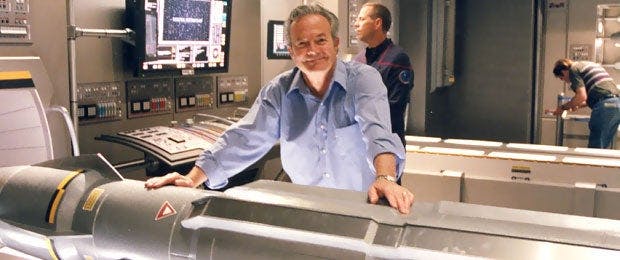
Herman Zimmerman and Star Trek are pretty much synonymous.
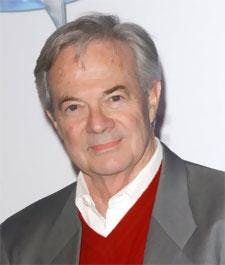
What’s life like for you now? How are you enjoying retirement?
Zimmerman: Well, I’ve been retired since 2005, when Enterprise was canceled. In the interim I’ve been doing interior design work. I haven’t actively pursued anything within the industry just because I think I’ve done enough motion pictures and television shows, and I like doing some other kinds of endeavors. I’ve read literally hundreds of scripts and done too many episodic television series to really want to continue doing that past 75 years. It’s just not… It’s a young man’s game and I’m happy to step back and let the younger guys go for it.
The TNG Blu-rays are being released season by season. What’s it like to see work you did 25 years ago coming out again in this new format and looking almost exactly like it did on the set and on film when it was first shot two-plus decades ago?
Zimmerman: The Blu-rays are really good. I was asked to come down to CBS to do an interview with the team that putting together the extras. That was fun. I sat with Ron Moore for quite a while and reminisced. They asked good questions. The clips I saw looked great, but I did not see the whole thing by any means. There again, been there, done that. I’ve got all the copies that were made originally. They’re not the digitally remastered ones, but I’ve got them if I ever want to see them. My involvement with TNG was really its inceptions, the creating of the basic look of the show, and the first season and a half, and maybe not even a full half, because I went on to do Star Trek: The Final Frontier. I asked Richard James to sub for me and he was so good at subbing for me that I just walked away from it. I did a number of other things and then came back to do DS9 and Enterprise and another five motion pictures. So that whole experience with TNG was just kind of a kick-start to my involvement with Star Trek in a real and personal way. Star Trek has been very, very good to me.
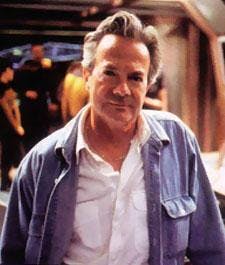
How was your relationship with Gene Roddenberry?
Zimmerman: I liked him immediately. He was a likable guy. He wasn’t always the nicest guy, but he was always nice to me, and I appreciated that. I think he knew his limitations stopped at the imaginary, at the writing concept level, because not everything that Gene created he personally wrote. He was, as I learned to be, very good at surrounding himself with people that knew as much or more than he did about whatever subject he was delving into. In the original series, Gene Coon wrote some of the best science-fiction. Some of it could also be pretty hokey, but because it was about the only thing like that on the air and, in a way, was the pioneering effort to put science-fiction, and particularly Gene’s humanist philosophy, on the screen, nobody was able to do it better. I liked Gene, as I say, and he called me “The Artiste,” which made me feel good.
Gene had, as many of the people in show business do, a drinking problem, and his wife Majel was really hard on him about it. So he wasn’t allowed to drink during the day, but every once in a while he’d meet the art department at lunch and have a beer. He liked that, and the art department liked that. We didn’t have a beer with him, but we were all having lunch and he’d slip in and quietly enjoy his beer without his secretary, who had a direct line to his wife, finding out about it. That’s just a stupid, silly sidebar, but he was that kind of a guy. He never wanted to hurt your feelings, but occasionally he had to get tough, though usually not with us in the art department. He was pretty tough on the writers sometimes.
During your Star Trek days, you earned four Emmy nominations…
Zimmerman: Yes, but I didn’t win one!
That was a shame…
Zimmerman: Thank you.
The 20th anniversary of Deep Space Nine passed not too long ago. So let’s talk for a few minutes about the show. Actually, let’s narrow it down to two vital episodes, “Emissary” and “Trials & Tribble-ations.”
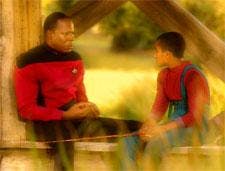
Zimmerman: (“Emissary”) was the pilot. It was brilliantly directed and, I thought, set up the entire series. The captain’s ship is blown up, his family is killed. He’s alone and desolate, and he gets this job at the far end of the galaxy. His journey is the journey of the series, and it’s to find the meaning in life that far away from everything that you know and love. In a lot of ways, DS9 is a very spiritual show. The spiritual aspect, certainly, was Michael Piller’s long suit and it was picked up by the writers in very significant ways. I think Gene would have been extremely proud of DS9.
“Trials and Tribble-ations” was so much fun because you had to interface real action going on on a real set with stuff that had been photographed decades before, and you had to make it work seamlessly. You had to make some of the actors who were acting in 1966 look like they were talking to actors who were working in 1996. That was a kind of thing that art directors and directors and writers, that people who do motion pictures love to do.
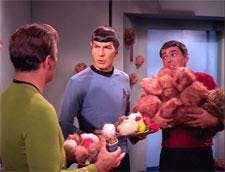
It’s fooling the audience, taking the A roll and the B roll from two different time periods and putting them together. I’d done re-creating of the original sets a lot of times, because I’d done several museum exhibits for the Star Trek franchise over the years. So I’d already built the original bridge in several different incarnations, and that was always a hoot. I’d always admired Matt Jefferies’ skill at putting sets together in such a way. Remember, when he was doing it, they were shooting with multiple cameras and they really was no third wall anywhere. The bridge was the only set that they completed all the way around, but it was mostly out, the wall that the camera was looking through.
You did not work on Voyager. That was just a matter of timing and there not being enough of you to go around, right?
Zimmerman: I didn’t do Voyager just because it wasn’t offered to me. Voyager started while DS9 was still in production. It was simple arithmetic that Richard James would go on to do Voyager because he had to adapt all of the sets that I had done for TNG to a new show. Also, the studio wanted to do it on a shoestring, not knowing if – excuse the pun – the thing would fly. They probably chopped his budget down to make a whole new look with maybe a two-episode budget. And he did a hell of a job, I think. But I was in no position to want to do that show. I was still deeply involved in DS9, and I wasn’t out of work too long after DS9 when Rick came up with Enterprise as a vehicle for the new UPN network.
How much like characters did you regard your sets? In other words, was the bridge as important as Kirk or Archer, etc.?
Zimmerman: Always, I think, in Star Trek and probably in Star Wars and to some extent in Flash Gordon, you would say that the vehicle is a character. The vehicle isn’t perfect. You and I have limitations that the vehicle is going to need to be repaired, the vehicle is going to have new innovations added to it, things that are tested and either added or not. You’re always dealing with the ship’s life support system because you’re out there in a void of space, and there’s not heat that isn’t somehow generated for you, no breathable air that isn’t somehow generated for you. You don’t exist out there without that ship working perfectly. When it works imperfectly, that’s another layer of story that you have to deal with. So, yes, I think that the Enterprise has always been one of the characters.
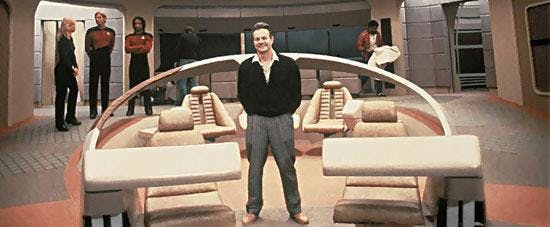
Last question. You’ve mentioned in the past that you hope to write a memoir. Is that still on your radar?
Zimmerman: I’ve always got it in my head to write a book. I collect little bits of things that occur to me. I’m a little Andy Rooney-esque, and maybe someday I’ll find a common thread and do that. As you can tell from my big mouth, I like to talk and I like words and I like making the words mean what I believe I want to say. So I wouldn’t say I ever wanted to be a writer, but maybe there’s an avocation there, a love of writing that might end up with my actually writing something.
